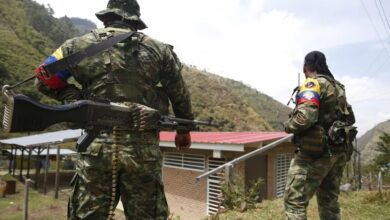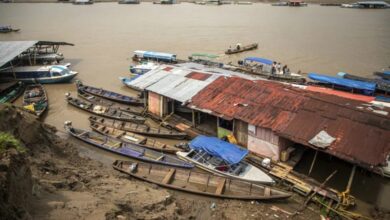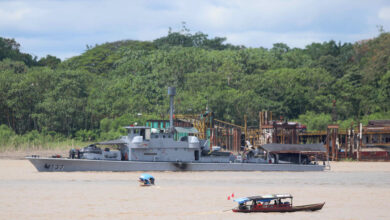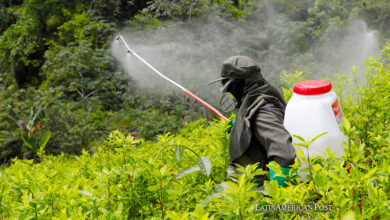Amazon River’s Drought is Disrupting Economy and Navigation
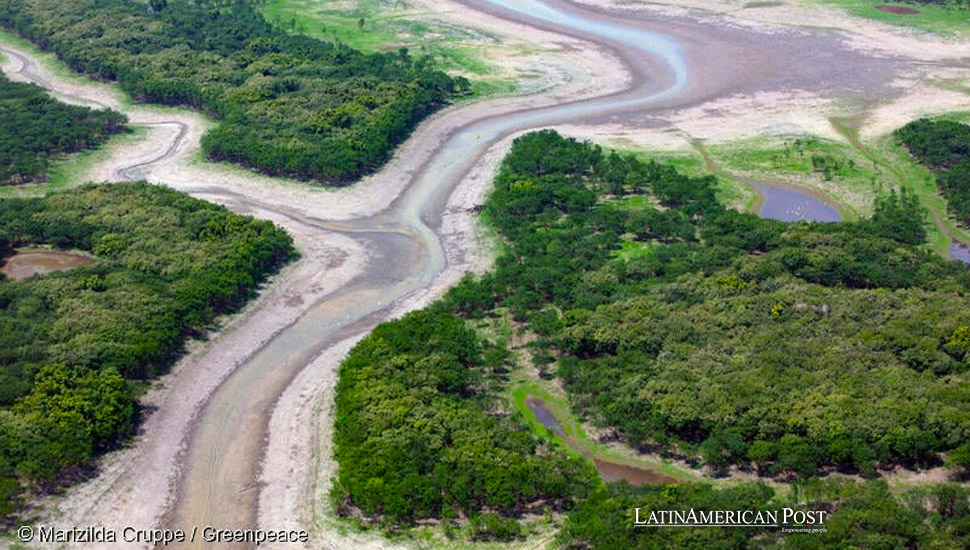
The Amazon basin is grappling with a severe water crisis, as record droughts and ongoing low rainfall are causing river levels to plummet. This environmental disaster is weakening the economy, hindering navigation, and isolating communities that rely on these waterways for survival.
The Amazon River, often called the “lungs of the Earth,” is a vital artery that sustains one of the world’s most important ecosystems. It supports millions of people, countless species of wildlife, and an economy that relies heavily on its vast network of waterways. But now, this lifeline is under threat. Last year’s record drought and ongoing lack of rainfall have caused water levels across the Amazon basin to drop to unprecedented lows. The consequences are severe: the region’s economy is faltering, navigation is becoming increasingly complex, and communities that have long depended on these rivers for their livelihoods are being cut off from the world.
The Impact of the Drought: A Region on the Brink
The Amazon is no stranger to seasonal fluctuations in water levels, but the recent decline is anything but typical. Last year’s drought was the worst, and the situation has only worsened. The Brazilian Geological Service (SGB) has been monitoring the situation closely, warning that all rivers in the Amazon basin are expected to drop below their historical levels. The Rio Negro in Manaus, for instance, is currently 21 meters deep—a sharp decrease from the 24 meters recorded at the same time in 2023. This significant drop is a clear indicator of the crisis at hand.
The reasons behind this dramatic decline are complex. Various factors, including deforestation, climate change, and natural phenomena like La Niña, influence the Amazon’s hydrological cycle. Last year, La Niña was expected to bring more rain to the northern parts of Brazil by cooling the Pacific waters near the Equator. However, these expectations were not met. The Pacific did not cool as predicted, and the anticipated rainfall never arrived. Instead, the Amazon faced the consequences of one of the driest periods in its recent history.
The ecological impact of this drought is staggering. Rivers that once teemed with life are now dangerously low, threatening the survival of countless fish species and other aquatic life. The drying streams are leaving behind beds of dead fish, a grim reminder of the river’s dwindling vitality. This decline in river health has a cascading effect, endangering the entire ecosystem that relies on the Amazon’s waters.
Navigating the Shallow Waters: Economic Struggles Amidst Falling River Levels
The economic repercussions of the Amazon’s water crisis are far-reaching. The Amazon River and its tributaries are vital trade routes for transporting goods such as grains, minerals, and fuel from the continent’s heart to ports where they can be shipped globally. However, navigation has become increasingly treacherous, with water levels dropping to record lows.
In Porto Velho, Rondonia state, the Madeira River—a crucial waterway for northern Brazil—has seen its depth fall below two meters since July, far below its normal depth of 5.3 meters. This dramatic reduction has had a significant impact on transportation, particularly for the barges that carry grains and other goods. These vessels, which require a certain depth to navigate safely, are now struggling to pass through some of the region’s key ports.
The Brazilian government, through its Department of Transport Infrastructure (DNIT), has begun dredging operations on critical points of the Madeira River and other major rivers like the Amazon and Solimões to maintain navigability. However, these efforts are only a temporary fix. The deeper issue lies in the unpredictability of the river levels, which makes long-term planning for navigation and trade incredibly challenging.
As a result, many companies are being forced to consider alternative routes and ports, such as those in the south and southeast of Brazil. Consultancy firm ARGUS has warned that the redirection of grain and fertilizer cargoes could lead to increased shipping costs for producers, further straining the region’s economy. The cost of moving goods through these alternative routes is significantly higher, and the delays caused by rerouting can disrupt supply chains, leading to economic losses that ripple across the country.
Industries in Manaus, particularly those in the Free Trade Zone, are also feeling the pinch. These businesses rely heavily on river transport to move their goods in and out of the region. With the Rio Negro’s water levels dropping, companies have requested that dredging work be expedited to prevent a repeat of last year’s disruptions. However, even with these efforts, the economic outlook remains uncertain. The combination of higher transport costs and the potential for further disruptions has many businesses on edge, unsure of how to navigate the challenges posed by the declining rivers.
Communities Cut Off
While the economic impacts of the Amazon’s water crisis are significant, the human cost is perhaps even more profound. Across the Amazon region, communities that depend on the rivers for their daily lives are facing isolation as navigability decreases. These rivers are not just highways for trade; they are the primary means of transportation for countless people who live in remote areas, far from roads or other infrastructure.
As the rivers recede, boats can no longer reach many of these isolated communities. Residents who once relied on river transport to buy food, access medical care, or sell their crops are now cut off, facing shortages and rising prices for basic goods. The situation is particularly dire for those who depend on fishing as their main source of income. As rivers and streams dry up, fish populations are declining, leaving riverside communities struggling to make a living.
The drought is also having a devastating impact on agriculture. Farmers in the region, who rely on the rivers to irrigate their crops, are finding it increasingly difficult to sustain their livelihoods. The lack of water is stunting crop growth and leading to lower yields, which in turn affects food security for both the local population and the wider region. With less produce to sell, farmers are earning less income, compounding the economic hardships faced by these already vulnerable communities.
The social implications of this isolation are severe. In some areas, children are unable to attend school because transportation has become too difficult. Access to healthcare has also been compromised, with some communities unable to reach medical facilities when needed. The isolation is not just physical but also economic and social, as communities become increasingly disconnected from the broader society.
Efforts to mitigate these challenges are underway, but the scale of the problem is daunting. Humanitarian organizations and local governments are working to provide emergency supplies to the most affected areas, but these measures can only offer temporary relief. The long-term solution lies in addressing the root causes of the crisis and finding ways to support these communities in adapting to the new realities of their environment.
Mitigating the Impact of Future Droughts
The ongoing water crisis in the Amazon raises critical questions about the future of the region and the strategies needed to mitigate the impact of similar events in the future. Climate change, deforestation, and the resulting changes in the hydrological cycle are likely to continue influencing the region’s water levels. As such, there is an urgent need for comprehensive strategies that address both the immediate challenges and the underlying causes of the crisis.
One of the key areas of focus must be on improving the management of the Amazon’s water resources. This includes better monitoring and prediction of river levels, as well as more effective planning for drought conditions. Investments in infrastructure, such as the expansion of dredging operations and the construction of water storage and irrigation systems, will be essential in helping the region cope with future droughts.
Another critical aspect is the need to protect the Amazon’s forests, which play a crucial role in regulating the region’s climate and water cycle. Deforestation not only contributes to climate change but also disrupts the natural processes that maintain the flow of water in the rivers. Reforestation and conservation efforts are therefore vital in preserving the health of the Amazon basin and ensuring that its rivers can continue to support the people and ecosystems that depend on them.
International cooperation will also be crucial in addressing the challenges facing the Amazon. The region is of global importance, and its health is closely linked to broader environmental and economic systems. By working together, governments, organizations, and communities can develop solutions that not only address the current crisis but also build resilience for the future.
Education and awareness will also play a key role in the long-term sustainability of the Amazon. By promoting understanding of the region’s ecological importance and the impact of human activities on its health, it is possible to foster a greater sense of responsibility and stewardship among those who live in and depend on the Amazon.
Finally, supporting the communities that are most affected by the water crisis is essential. This includes not only providing immediate aid but also helping these communities adapt to the changing environment. Developing alternative livelihoods, improving access to education and healthcare, and strengthening social networks are all critical components of building resilience in the face of environmental change.
A Critical Moment for the Amazon
The Amazon basin is at a critical juncture. The ongoing water crisis, driven by last year’s record drought and continued low rainfall, has exposed the region’s vulnerability to environmental changes. The declining rivers are not just a natural phenomenon; they are a reflection of the broader challenges facing the Amazon, from climate change to deforestation and beyond.
The impact of this crisis is being felt across the region, from the struggling economies that rely on river transport to the isolated communities that depend on these waterways for their survival. The Amazon’s rivers, once powerful and life-sustaining, are now shrinking, creating a cascade of challenges that threaten both human livelihoods and the environment.
As the situation in the Amazon continues to unfold, it is clear that urgent action is needed. The region’s future depends on the ability to address both the immediate impacts of the drought and the longer-term factors contributing to the crisis. This includes improved water management, investments in infrastructure, reforestation, and international cooperation. Additionally, there must be a focus on supporting the most vulnerable communities, helping them adapt to the new realities they face, and ensuring that they are not left behind.
The Amazon is more than just a river basin; it is a vital part of the global ecosystem, and its health is closely linked to the well-being of the planet. The current crisis serves as a stark reminder of the interconnectedness of environmental and human systems. As such, the challenges facing the Amazon should be seen as a global concern, requiring collective action and a commitment to sustainability.
Also read: Cuba Tightens Regulations on Private Businesses Amid Economic Crisis
The lessons learned from this crisis will be crucial in shaping the future of the Amazon and other vulnerable regions around the world. By taking decisive steps now, it is possible to protect the Amazon’s rivers, preserve its biodiversity, and ensure that the millions of people who depend on it can continue to thrive. The stakes are high, but with the right strategies and a shared sense of responsibility, there is hope that the Amazon can recover and continue to be a source of life and prosperity for generations to come.

